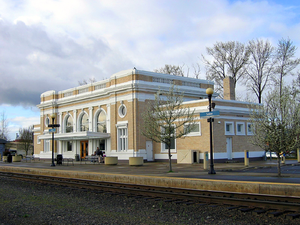 When this station was built in Salem in 1918, we were near "peak trains." Would they have sent you to the State Hospital if you told them that, within a generation, the expensive new building would be a relic? Image via Wikipedia
When this station was built in Salem in 1918, we were near "peak trains." Would they have sent you to the State Hospital if you told them that, within a generation, the expensive new building would be a relic? Image via Wikipedia
This past Friday I took the day off to take care of accumulated errands. Since I was driving through 8 towns that day I decided – out of curiosity - to stop by their town halls- er, I mean, “municipal offices” and ask what their funding plans were if the economy didn’t recover.Another replied:To maintain credibility I will not repeat the answers I heard.... But I will recommend that everyone try this at least once.
Let me guess; none even considered the option that the economy will not recover.How would Salem fare on this minimal governmental alertness test? I listened to a city official this weekend discuss some rather unpleasant budget projections for the upcoming years, although he referred to "the recovery" in his talk. What are the plans down in City Hall if this IS as recovered as it gets, and it only gets worse from here?
You may not think that likely, and it may or not be desirable that "growth" be only something seen in history. But it's hard to argue that planners who don't consider scenarios other than "the future will be like the past" are anything but a giant waste of money.
Speaking of obtuse "planning," there was a meeting of an "Advisory Committee" connected to the third bridge boondoggle today, ably captained by a young woman from the high-priced global consulting firm CH2M-Hill. Her job, as she explained repeatedly (in not so many words), was to prevent the committee from actually advising about the core issue (whether it makes any sense at all for Salem to blow more than $0.5 billion of borrowed money on a new auto bridge over the Willamette to solve "peak hour congestion" that lasts for no more than one hour and causes the average West Salem commuter to spend a full TWENTY MINUTES commuting in his or her car, alone).
Instead of grappling with that issue --- which must surely be considered central to the question of alternatives --- the group was repeatedly cautioned that they were to consider the new bridge a foregone conclusion and to develop ideas for making it less bad.
In other words, the group, although called an "alternatives" steering committee, is actually only about keeping the weirdo bicycling and transit types busy on a harmless gerbil wheel while the real work of ramming through the new auto bridge gets done. The real work of interest to the highway lobby proceeds apace, without any delay to incorporate any insight that the "alternatives" group might produce. This is normal as the highway lobby, and their servant agency known as ODOT, has zero interest in anything other than pouring concrete.
That is, the whackos who think about bikes and pedestrians and transit are free to debate and discuss ways to improve the boondoggle, so long as they don't question the boondoggle itself (or point out that, by definition, a gigantic new auto span will make the city much more hostile to pedestrians and bicycles everywhere).
Moreover, all discussions were in reference to a "Trip Demand Model" run for the year 2031 --- a model which includes
- (a) nothing about the price of gasoline;
- (b) nothing about Peak Oil;
- (c) nothing about Oregon's supposed greenhouse gas emissions goals;
- (d) nothing about the last two years first-in-history decline in annual vehicle miled-driven; or
- (e) the collapse of the US credit markets and auto industry.
So even as oil starts making its summer sojourn back towards $100/bbl, we've got roomsful of planners who scrupulously avoid any data that might lead to an act of actual planning occurring, because the data isn't in their model (and thus doesn't exist) and they don't update their model or get a better one because then it wouldn't produce the answer desired.
Building a new auto bridge in Salem (or anywhere else in North America) is a lot like ordering a stateroom on the Titanic after hearing about the iceberg collision.
(Timely: Kurt Cobb has a great piece on infrastructure collapse, which is only accelerated by trying to build more than you can maintain. Oregon and Salem already complain about being overwhelmed by a maintenance backlog; apparently, when it comes to roads, when you find yourself in a deep hole, the only solution is to dig yourself in deeper, faster.)

![Reblog this post [with Zemanta]](http://img.zemanta.com/reblog_e.png?x-id=9c75ba0d-869d-4f18-898a-61370dd19c39)



